 |
 |
Our enthusiastic and extremely knowledgeable perennials team is here to answer your questions and help you choose the best perennials for your situation. There’s always something in bloom for sun, shade, butterflies, birds or deer resistance as well as a variety of bulbs for your space.
Stroll through our time-tested favorites and introduce yourself to the newest varieties. We garden with perennials too; we love them and it shows!
|
56 found, showing page 3 of 4
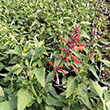
Fragrant mounding foliage with coral-pink flowers. Long bloomer. Heat & humidity tolerant. USDA 5-10
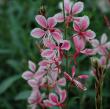
Rose pink blooms on rigid stems. Naturalizing. USDA 5-8 'Siskiyou Pink' prefers full sun and is happy in average to poor, well-drained soil. Wandflower is a tap-rooted perennial so it is very drought tolerant. The tap root makes these difficult to move once they are settled in, so site them carefully.
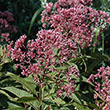
Pink blooms. Tolerates clay & wet soils. Native cultivar. Naturalizing. USDA 4-8
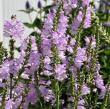
Pink blooms. Compact habit. Slow spreading cultivar. USDA 3-9
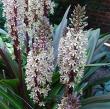
Pinkish blooms. Purple foliage. Prefers rich, Well-drained Soils. USDA 6-9
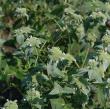
PYCNANTHEMUM MUTICUM 1 Gallon | Mountain Mint | Pink blooms. Fragrant silvery foliage. Naturalizing. Native. USDA 4-8

Pink blooms on flushed bronze foliage. Tolerates wet soils. USDA 6-10
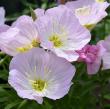
Light pink blooms. Long blooming, easy care plant. Naturalizes quickly. USDA 5-9

Hot pink blooms. Spreading foliage. Mildew resistant. USDA 7-11
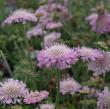
Pale-pink blooms. Long blooming. Compact. Clump-forming. USDA 5-9
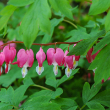
Height: 3 feet
Spacing: 30 inches
Sunlight: partial shade full shade
Hardiness Zone: 1b
Other Names: Old Fashioned Bleeding Heart
Description:
Bushy upright mounded selection features blue-green fern-like foliage and arching stems of heart shaped locket flowers with white protruding petals; excellent for shaded borders and beds; beautiful cut flower; goes into summer dormancy
Ornamental Features:
Common Bleeding Heart features delicate nodding pink heart-shaped flowers with white tips dangling from the stems from late spring to early summer. Its ferny compound leaves remain bluish-green in color throughout the season.
Landscape Attributes:
Common Bleeding Heart is an herbaceous perennial with a mounded form. Its relatively fine texture sets it apart from other garden plants with less refined foliage.
This plant will require occasional maintenance and upkeep, and should be cut back in late fall in preparation for winter. It is a good choice for attracting butterflies to your yard, but is not particularly attractive to deer who tend to leave it alone in favor of tastier treats. It has no significant negative characteristics.
Common Bleeding Heart is recommended for the following landscape applications:
- Mass Planting
- General Garden Use
- Planting & Growing
Common Bleeding Heart will grow to be about 3 feet tall at maturity, with a spread of 3 feet. When grown in masses or used as a bedding plant, individual plants should be spaced approximately 30 inches apart. It grows at a medium rate, and under ideal conditions can be expected to live for approximately 15 years. As an herbaceous perennial, this plant will usually die back to the crown each winter, and will regrow from the base each spring. Be careful not to disturb the crown in late winter when it may not be readily seen! As this plant tends to go dormant in summer, it is best interplanted with late-season bloomers to hide the dying foliage.
This plant does best in partial shade to shade. It prefers to grow in average to moist conditions, and shouldn't be allowed to dry out. It is not particular as to soil pH, but grows best in rich soils. It is somewhat tolerant of urban pollution. Consider applying a thick mulch around the root zone over the growing season to conserve soil moisture. This species is not originally from North America. It can be propagated by division.
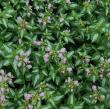
Pink blooms. Green leaves have white diamond. Groundcover. USDA 3-8
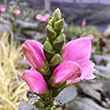
Uniquely shaped, hot pink blooms atop dark green leaves with a bronzy sheen.Best of moist or wet shade. Showy and long lived. USDA 4-9
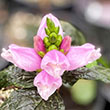
Height: 3 feet
Spread: 3 feet
Sunlight: full sun partial shade
Hardiness Zone: 4a
Other Names: Lyon's Turtlehead, Shellflower
Description:
Lush deep-green, shiny leaves topped with hot rosey-pink flowers which are shaped like little turtle heads; tolerant to moisture, this spreading plant is fantastic for stream edges and in bog gardens
Ornamental Features:
Hot Lips Turtlehead has masses of beautiful hot pink hooded flowers at the ends of the stems from late summer to mid fall, which are most effective when planted in groupings. The flowers are excellent for cutting. Its glossy pointy leaves remain dark green in color throughout the season.
Landscape Attributes:
Hot Lips Turtlehead is a dense herbaceous perennial with an upright spreading habit of growth. Its medium texture blends into the garden, but can always be balanced by a couple of finer or coarser plants for an effective composition.
This plant will require occasional maintenance and upkeep, and is best cleaned up in early spring before it resumes active growth for the season. Gardeners should be aware of the following characteristic(s) that may warrant special consideration: Spreading
Hot Lips Turtlehead is recommended for the following landscape applications:
- Mass Planting
- General Garden Use
- Naturalizing And Woodland Gardens
- Bog Gardens
Planting & Growing:
Hot Lips Turtlehead will grow to be about 3 feet tall at maturity, with a spread of 3 feet. Its foliage tends to remain dense right to the ground, not requiring facer plants in front. It grows at a medium rate, and under ideal conditions can be expected to live for approximately 12 years. As an herbaceous perennial, this plant will usually die back to the crown each winter, and will regrow from the base each spring. Be careful not to disturb the crown in late winter when it may not be readily seen!
This plant does best in full sun to partial shade. It prefers to grow in moist to wet soil, and will even tolerate some standing water. It is not particular as to soil pH, but grows best in rich soils. It is somewhat tolerant of urban pollution. Consider applying a thick mulch around the root zone over the growing season to conserve soil moisture. This is a selection of a native North American species. It can be propagated by division; however, as a cultivated variety, be aware that it may be subject to certain restrictions or prohibitions on propagation.
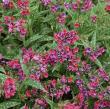
Prolific raspberry-pink blooms. Upright silver-spotted foliage. USDA 3-9
56 found, showing page 3 of 4





